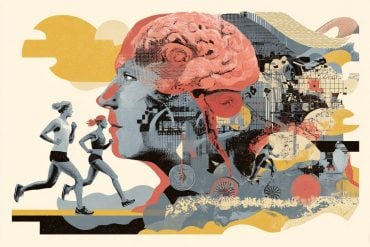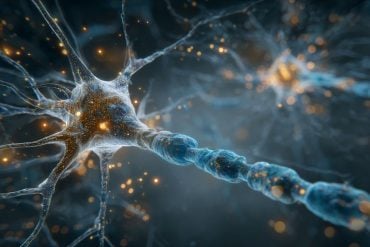Summary: A new study reveals that a small cluster of cells near the brain’s “blue spot”—the locus coeruleus—helps regulate arousal, attention, and stress responses. These peri-LC neurons modulate the locus coeruleus by releasing GABA, which reduces its activity and dampens the release of norepinephrine.
This system allows the brain to respond differently to various challenges, such as suppressing pain while heightening motor activity in emergencies. Researchers used advanced techniques to map and profile these neurons, uncovering distinct subtypes in both regions.
Key Facts:
- Peri-LC Role: Peri-LC neurons regulate arousal by inhibiting locus coeruleus activity using GABA.
- Dual Modulation: The brain tailors its response to threats by fine-tuning different systems—like enhancing movement while suppressing pain.
- Therapeutic Potential: Targeting this circuit may help treat anxiety, PTSD, and symptoms of opioid withdrawal.
Source: University of Washington
A small cluster of cells deep within our brains, called the locus coeruleus, affects how awake and attentive we are, how we respond to stress, how we cope with anxiety and fear, and how we create memories and learn.
The locus coeruleus, Latin for “blue spot,” is also involved in a wide range of neurological and neuropsychiatric conditions such as anxiety and depression, post-traumatic stress disorder and Alzheimer’s diseases.

Yet despite its importance, relatively little is known how the locus coeruleus works. It is known to receive inputs from throughout the central nervous system and to send signals, in the form of the chemical norepinephrine, across the brain.
It has not been clear, however, how it processes the information it receives, nor how that affects how much norepinephrine it releases, and where.
Now a new study in mice shows that a small group of cells next to the locus coeruleus, called peri-LC neurons, appear to play a key role in regulating its information-processing.
The findings help explain how we respond appropriately to different challenges, according to Andrew Luskin, a postdoctoral associate in the Laboratory of Neural Dynamics & Cognition at Rockefeller University in New York.
Luskin, who conducted the research while he was a graduate student at the University of Washington School of Medicine, is the co-first author of the study with Dr. Li Li, assistant professor of anesthesiology and pain medicine at the UW School of Medicine and a principal investigator at Seattle Children’s Research Institute.
“Traditionally, the peri-LC has been thought of as sort of a ‘dimmer switch’ for the brain’s level of arousal,” Luskin said, “which globally affects locus coeruleus firing — from a lot, when you’re extremely anxious, to a little, when you’re asleep, and somewhere in the middle when you’re alert but relaxed.”
Scientists have inferred that the locus coeruleus must play a nuanced role.
“If your toddler runs out into the street, you want your motor system tuned up so you can chase after them,” Luskin said.
“But you also want your pain system tuned down, so if you stub your toe as you run, you’ll ignore the pain and focus on catching the child. It is possible that these responses are being fine-tuned by the peri-LC.”
In their study, the researchers observed how neurons in the peri-LC responded when the mice were exposed to different stimuli that increase arousal.
They found these stimuli tended to cause the peri-LC to release the inhibitory neurotransmitter gamma-aminobutyric acid, or GABA. To varying degrees, this decreased the firing of locus coeruleus neurons and reduced their release of norepinephrine.
“The peri-LC cells apparently act like a radio gain circuit that can dial up or down the strength of the locus coeruleus cells’ response to incoming signals,” said senior author Michael Bruchas, professor of anesthesiology & pain medicine, pharmacology and bioengineering. He is an investigator at the UW School of Medicine’s Center for the Neurobiology of Addiction, Pain and Emotion.
The research team analyzed the anatomy of the peri-LC and detailed how various groups of its neurons affect the neuronal activity of the locus coeruleus differently.
The analysis showed that, like the locus coeruleus, the peri-LC neurons receive inputs from major centers of the brain and spinal cord but transmit signals almost exclusively to the locus coeruleus. These signals inhibit locus coeruleus neuron firing.
The team also used a technique called single-cell RNA sequencing to identify the different types of neurons in the locus coeruleus and peri-LC, and another technique called pixel-seq to map their exact locations.
These investigations revealed that both the locus coeruleus and peri-LC have distinct subpopulations of cells, likely with different functions.
Besides advancing understanding of how our brains regulate arousal, attention and our response to stress and fear, the findings open the possibility of new ways to treat neurological and neuropsychiatric disorders, said Li, who studies opioid drug withdrawal.
“During withdrawal, for example, we know the locus coeruleus becomes hyperactive,” Li said.
“With these findings we may be able to identify drug targets either in the locus coeruleus or the peri-LC that will reduce withdrawal symptoms.”
The paper provides researchers with what Bruchas described as a “detailed roadmap” for studying the locus coeruleus and peri-LC.
“The finding shows us who the key players are, how they connect, and the neurotransmitters involved,” he said. “It will open a lot of doors for a lot of labs.”
About this neuroscience research news
Author: Leila Gray
Source: University of Washington
Contact: Leila Gray – University of Washington
Image: The image is credited to Neuroscience News
Original Research: Closed access.
“Heterogeneous pericoerulear neurons tune arousal and exploratory behaviours” by Andrew Luskin et al. Nature
Abstract
Heterogeneous pericoerulear neurons tune arousal and exploratory behaviours
As the primary source of noradrenaline in the brain, the locus coeruleus (LC) regulates arousal, avoidance and stress responses.
However, how local neuromodulatory inputs control LC function remains unresolved.
Here we identify a population of transcriptionally, spatially and functionally diverse GABAergic (γ-aminobutyric acid-producing) neurons in the LC dendritic field that receive distant inputs and modulate modes of LC firing to control global arousal levels and arousal-related processing and behaviours.
We define peri-LC anatomy using viral tracing and combine single-cell RNA sequencing with spatial transcriptomics to molecularly define both LC noradrenaline-producing and peri-LC cell types.
We identify several neuronal cell types that underlie peri-LC functional diversity using a series of complementary neural circuit approaches in behaving mice.
Our findings indicate that LC and peri-LC neurons are transcriptionally, functionally and anatomically heterogenous neuronal populations that modulate arousal and avoidance states.
Defining the molecular, cellular and functional diversity of the LC and peri-LC provides a roadmap for understanding the neurobiological basis of arousal, motivation and neuropsychiatric disorders.






